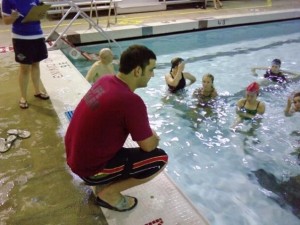In some cases where chlorine leak occurred, it has caused several issues involving breathing issues, skin irritation and blistering around the mouth and eyes. The risk for chemical burns due to excessive chlorine levels especially exposure to chlorine gas is increased at indoor pools with poor ventilation. In a study conducted, chlorine is considered as a poison and children are highly sensitive to the elevated levels of the caustic chemical than adults.
Chlorine used in swimming pools
Pool managers and homeowners utilize chlorine in swimming pools to eliminate bacteria and reduce algae and control the pH levels. The antimicrobial pesticides which are additives such as calcium or sodium hypochlorite that has chlorine and other substances are added into the water in tablet, granule or liquid form.
In some cases, pool managers utilize devices that automatically release the specific amount of chlorine into the pool at timed intervals. The level of chlorine in the swimming pool as well as the length of the exposure of the child can determine the severity of a reaction.

Level of chlorine
The level of chlorine in swimming pools and commonly used household products tend to differ. Even though household cleaners contain about 2% chlorine content while bleach has 5%, the swimming pool chemicals have 12-95% chlorine content since proper usage of the product requires dilution with water to achieve a safe balance. It is important to follow the safety guidelines in the addition and maintenance of the chlorine levels in swimming pools.
Dangers
Children who swim in chemically-treated pools face a higher risk of inhaling dangerous amounts of chlorine and related products. Since most cases of dangerous exposure is via the inhalation of chlorine gas, the risk is higher among children whom swim often in indoor pools.
The high levels of chlorine either through excess amount in the pool water or from the leak of gases, can lead to severe irritation to the skin, eyes, nose and sinuses. The exposure can lead to respiratory issues and if ingested, can cause burns on the throat. Chlorine is capable of causing chemical burns to damaged skin. Take note that exposure to elevated amounts of chlorine can lead to burns in skin, eyes and throat as well as death. If you will enroll in a first aid class, you can learn the steps to manage the condition.
Safety precautions
The child can be protected from chlorine burns by following the instructions for adding chlorine to the pool or by checking the management at indoor or public pools regarding the safety practices.
The indoor water pools and parks must have air-control mechanisms to eliminate the moisture from the air and continuously take in fresh air. The indoor pools can further ensure the safety by utilizing fans and open windows to boost the ventilation. In case the facility is designed to allow sunlight to strike the water, the possibility for the build-up of chlorine gas is minimized.
Important considerations to bear in mind
Exposure to chlorine gas entails immediate removal to an open space with fresh air and emergency medical care. It is recommended to rinse the skin and eyes using water to clear out the irritant. The individual should leave the pool and notify the management if there is a stronger than usual smell of chlorine or if there is any irritation to the eyes or skin.
